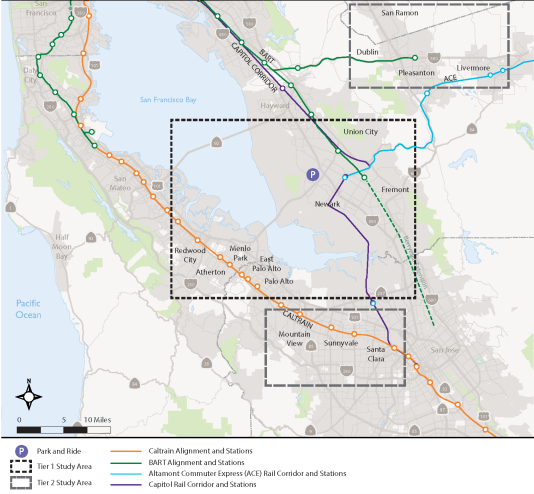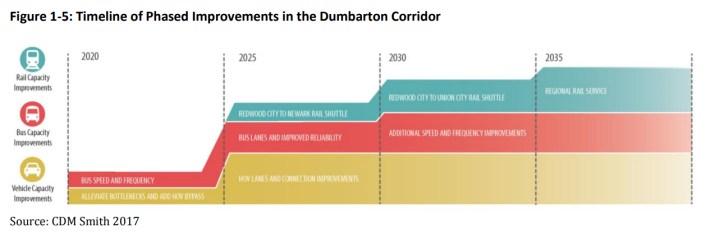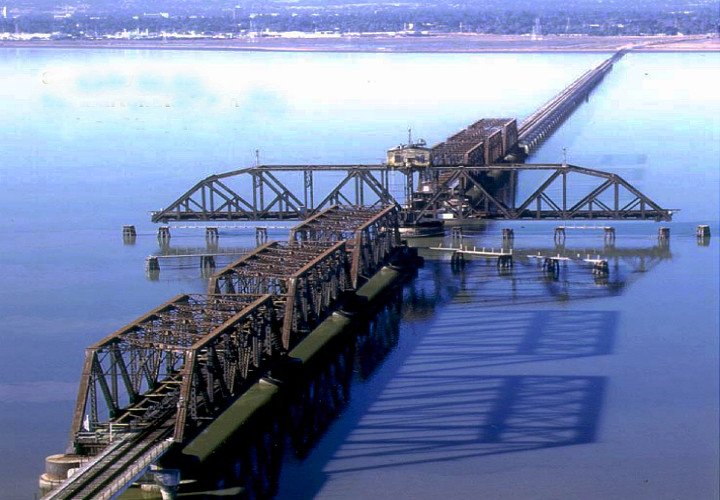The San Mateo Transit District (SamTrans) released its report today on improving transportation links across the Dumbarton bridge and right of way. The agency will be soliciting public comment on the document--which runs 267 pages--over the next couple of months. The study proposes phased implementations of improved bus services and, somewhere down the line, rebuilding either a one-or-two track rail bridge that would eventually permit Caltrain to connect the job centers of the Peninsula with the East Bay. The full report is available for download here.
Reviving this rail crossing (the existing bridge, which carried mostly freight, was destroyed in a fire in 1998) is something planners have blue-skied about for decades. SamTrans purchased the Dumbarton Rail Bridge and ROW between Redwood Junction and Newark Junction in 1995, anticipating eventual reinstatement of rail service on the route.
Plans festered until January of last year when Facebook, which built its campus along the Menlo Park side of the crossing, put up funds for a new study.

Notably, the study authors are abandoning the either/or approach of many planning documents. Instead, they are looking to phase in services that can be improved over time. For example, they propose running a rail "shuttle" service connecting the East Bay to Redwood City, where riders could transfer to Caltrain. While not ideal, it would allow increased mobility while questions about extending electrification (to allow Caltrain to access the East Bay), integrating with Amtrak's Capital Corridor, and interlining with freight services are answered. The study also doesn't propose choosing between dedicated bus lanes and rail, but rather proposes phasing in both, since they serve different markets, with better bus services on the existing road bridge in the short term. From Streetsblog's perspective, this addresses a fundamental flaw with many past studies that pits mode against mode, instead of acknowledging that different modes serve different markets.

It also aims to make the best use of existing highway lanes rather than widening roads. "...we are happy that they are proposing a way for public transit, vanpools and other high-occupancy vehicles to get out of traffic on the Dumbarton Corridor. It is the first agency study to fully recommend conversion of existing general purpose lanes to express lanes to make this happen, rather than in widening the road," wrote Stuart Cohen, co-founder and Executive Director of TransForm, in an email to Streetsblog.
However, Adina Levin of the 'Green Caltrain' blog took issue with how the study treats pedestrian and bike connections on the corridor:
The study does not consider bicycling as a commute mode, even though there is robust recent data from nearby Stanford and Google showing a 20 to 30 percent bicycle commute mode share for people who live within 5-10 miles of their workplace.
By ignoring these robust new information sources, the study favors long-distance commuters and neglects an opportunity for sizeable mode shift among shorter-distance commuters.
Either way, with a price tag estimated around $2.58 billion to build things out, funding will be challenging. The study proposes several potential revenue streams, including cap-and-trade funds and sales tax measures. "Overall, it is great to see an ambitious, multi-modal plan that is expected to get much more ridership than earlier studies, which would justify investment," wrote Levin, in an email to Streetsblog. "Better Transbay transit across Dumbarton is badly needed and worth doing."
To learn more about the study and what is being proposed, be sure to attend one of the upcoming public meetings or comment online or by phone as indicated below. And let Streetsblog know what you think about rebuilding the rail bridge and improving links along the corridor.
Public Meetings
Tuesday/tonight! August 15, 2017
6:30 p.m. – 7:30 p.m.
Union City Library
34007 Alvarado-Niles Road, Union City, CA 94587
RSVP here.
Wednesday, August 16, 2017
6:30 p.m. – 7:30 p.m.
East Palo Alto Library/City Hall
Community Room
2415 University Avenue, East Palo Alto, CA 94303
RSVP here.
Comments will be recorded at meetings; additional comments can be submitted in the following ways:
Email: reggiardom@samtrans.com
Telephone: 650-508-6283
Mail: Attention Melissa Reggiardo,
San Mateo County Transit District,
P.O. Box 3006,
1250 San Carlos Avenue,
San Carlos, CA 94070
Click HERE for additional contact information or to leave a comment.
SamTrans staff will also be presenting the study as part of the already scheduled public meetings listed below:
Thursday, August 17, 2017 at 7 p.m.
County of San Mateo Bicycle and Pedestrian Advisory Committee
San Mateo City Hall
330 W. 20th Avenue, San Mateo
Thursday, August 24, 2017 at 7 p.m.
North Fair Oaks Community Council
Fair Oaks Community Center
2600 Middlefield Road, Redwood City
Tuesday, August 29, 2017 at 7 p.m.
Menlo Park City Council
Menlo Park City Hall
701 Laurel Street, Menlo Park
Tuesday, September 12, 2017 at 6 p.m.
Redwood City Complete Streets Advisory Committee
Redwood City Hall
1017 Middlefield Road, Redwood City






